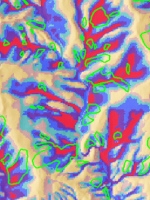 |
Welcome to the websites of Martin Mergili |

UNIVIE 290.044 PS3 WS2016 2015
Martin Mergili
In geomorphology, computer models are often employed to analyze or to predict spatial patterns, to improve process understanding, or even to anticipate the occurrence and characteristics of possible future processes. This course introduced to the key aspects of computer modelling. It built on examples related to landslide processes and fluvial geomorphology. The modelling techniques were strongly related to the application of Geographic Information Systems (GIS).
The course largely followed a concept of learning by doing. Specific real-world problems were taken as examples. The various aspects of modelling were elaborated by introducing step-by-step solutions of those problems. Even though the course was coupled to specific software packages, it introduced general skills which can be applied with various tools. It also attempted to convey a feeling of which methods are appropriate for which types of tasks. At the end of the course the participants
- were able to critically evaluate model results;
- were able to apply computer models in an independent and responsible way;
- knew the most important software packages for modelling of mass movements and their scope of application;
- knew about the possibilities to develop their own model applications;
- were able to design simple model applications by themselves.
Some basic knowledge of GIS (in particular, raster analyses with ArcGIS) was expected from the participants.
The course took place in the GIS laboratory on the 1st floor of the NIG Building (Universitätsstr. 7). It built on eight lessons of introductory lectures and code development. Seven more lessons were dedicated to practice and to the final exam. Each lesson had a duration of three teaching units.